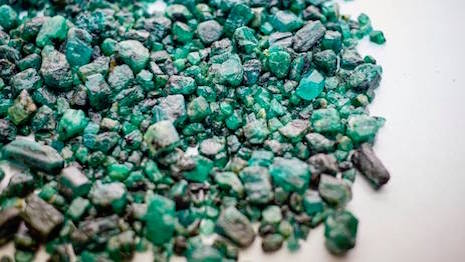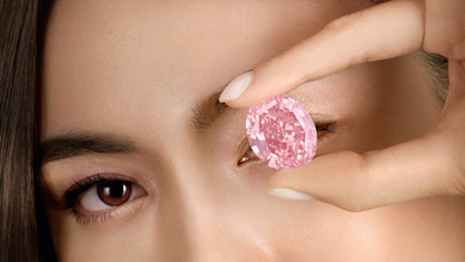While record-setting diamond sales dominated the headlines in 2017, it is colored gemstones' huge projected growth that will be of special interest to investors in 2018.
Researchers at Fura Gems estimated that the global market for gems could reach $10 billion in the next decade, while the Pink Star diamond was sold last year for $71 million, making it the most expensive jewel ever purchased. These data points show that not only are the markets for gems and colored diamonds healthy, they are also prime for wealthy investors to pour their money into.
Gemstone boom
After the Pink Star Diamond was sold in Hong Kong last year, a pair of pink and blue diamond earrings was sold in Geneva for $57 million altogether. In October, a red diamond was sold in Brazil for a rumored $10 million.
The robust interest in colored diamonds at auction throughout 2017 suggests that the category is in high demand among consumers.
But while colored diamonds have fetched noteworthy prices, it is gemstones that have proven to have true growth potential over the next year.
While traditionally selling for less than diamonds, last year colored gems sold at new record prices. For example, a 5-carat sapphire that sold for $10,000 in 1965 recently sold for $1 million.

The 2017 Fantasy Bra by Mouawad. Image credit: Victoria's Secret
Similarly, the famous Rockefeller Emerald sold for a record $5.5 million in June of 2017, making it the most expensive per-carat emerald ever sold.
In the last decade, prices for non-diamond gems have increased by 100 percent, according to a study from the Natural Resource Governance Institute.
Currently, rubies, emeralds and sapphires make up only $2 billion of the $23 billion gemstone industry, which includes diamonds. However, some predictions show that that share could grow to $10 billion within the next 10 years.
Diamonds are forever
Auctioneer Sotheby’s jewelry sales had a milestone year with total of $551.3 million achieved worldwide.
Sotheby’s 2017 sales total was driven by a number of major auctions, including the record-achieving sales of the Pink Star and the aforementioned blue and pink diamond earrings. The auction and resale markets in general have been seeing a period of rapid growth as consumers look to obtain goods with providence as well as one-off items others are unable to purchase (see story).
The increased demand for gemstones has had the additional effect of inspiring more gemstone mining companies to up their marketing.

Raw emeralds sourced by Gemfields. Image credit: Gemfields
For instance, colored-gemstone miner Gemfields unveiled a laser-inscribed emerald as part of its overarching transparency approach to sourcing precious stones.
The 4.11-karat emerald is believed to be the world’s first colored gemstone to be laser-inscribed with traceability information and a personalized message. Diamond jewelry company De Beers’ ForeverMark division has executed a similar strategy for diamonds, inscribing each stone with a unique code that allows the consumer to verify and view its origins (see story).
These gems have even made their way into the fashion world when Swiss-Emirati high-jeweler Mouawad walked its savoir-faire down the runway of last year’s Victoria’s Secret Fashion Show in Shanghai Nov. 28.
Mouawad has worked with Victoria’s Secret since 2001 and has designed 10 of the U.S. lingerie brand’s Fantasy Bras, with the 2003 edition earning the jeweler a Guinness World Record for the most-expensive bra ever made due to its high concentration of rare gemstones. Collaborating with Victoria’s Secret on such a high-profile, one-off piece allows Mouawad to demonstrate its abilities in high-jewelry design (see story).
Similarly, Russian jeweler Fabergé is prompting consumers to look beyond diamonds for their engagement rings with a colorful digital campaign.
The brand’s #SayYesInColour film tells color coordinated stories of proposals to showcase the brand’s emerald, ruby and sapphire engagement ring collection. While still an unconventional choice, depicting the women’s enthusiastic responses may help convince consumers to consider a colored stone (see story).
{"ct":"L8I1f8Vku41Vl9kjcAkjWhqmuDFSgBK\/91mJALS6sBZmu100PA5tJvA1IzXSa2\/Tx8sdTX1BYSzpfglbyxWwFiPDH2cu+kw9JicZQw8ZGKMJyevY4oesq0W1Pz+2ON6eY4VCiofsSozIzvM\/OFr7jgn3sQbcOnjlTJ92d\/o9KxOp8pWxEFMIz73k7hHl+lLPYCQUxrZh8EUc8vb8bVcRy1iEmb+CU3nQrGVAehp+dbTSil9RK2Z6rr16J86GPlSh0G5pO9c0YI+4mHDQ9UJO9G1Lv80sWze\/qMAuu7MpjJ07PZwJbO4d77+lZ9k0EFzQdmn9sy0W68R0EUyJJrPux1DgGs3tPx\/MAtYy5ZkjBsAVVPhWiYt1w02NUcpb9P9ZGW18QpOmDAD2pHb8CkSA6I1ZLRPOgDYwb4rVc9SJcqfjBNU3NArg3YJ5qwcan\/rzXHLSwHwPOHFbFDhWS9xlnSjpPxdXESaA4HFMRRWn3yooKnFkxLy12OXmyWks9i3HTGpXvHb6+gS+cVkbZww+nmxEnVIgYTgbi7GzW1N4tcL9um+tBMcW7dvLY9WC\/cJqpI91T3Sxe1NcpV\/MeaBQEcMiLHss5BamvAJE8q0d115tCaO6eBJDZUlTvnK1UMlAoMhLQj4rOV+8oQvjd7Kxmu9rSNML8ZnJ\/5tFsiocvz1e\/44RKKsCnjUWr+b5JRt1cQYHW4j38FPw3gM7a+GbpwvEVIZmLCvSVNTL\/B2WxdOiQ1AmNRcyoeACHDLHVqkfEtglx0DSN6sXSu1dJlSM4rNxMK2w9c4v1zReAVX4BbLVtuwE0RYi9+1hXK\/fJIrBr9M+HUlIYpCNySDwnDrAoaZh5+UautBP6Omogi+BRxq4KsRet699LOcI3qClskFrHZ6t5bWGScpcj3I4X0jH8efJkeZp9WK3oL43vJTbhVufX8I0h8XkUaLFCpQmALXCgJC5zfSo3ybDnVx0Dgj1ZK0xpq\/R3yS0fIL7pjGSIV38gEJsITTXv417usMvXRlnS8LmyAR7LynpLmhyGK7tyBIosdoHDF1juk51AXFgakjrn\/gJr\/zTHi+077YHoFzz7L4hvEP9TT5vkVdMuH\/y6VxoOnhD8kdt+AN0Py\/VriikNQBrZ0yGN0aU9b46PwMdhNuSrzOqWZoFFAncoLdR3ZxhfoPMO23N7T\/jr3Ra9wruF6002v98lQVjlFBAyl4eB3Qu3gcP9LwZdM+FZE7pXR8n4FsGbFSJCuMU4rCZ7uvGKaGD1RJJPBj+p7MWCwwzn3LwIG6w0hZiqOfaYfAEHtBDw8qdhpJ4A+VoXL3VGjy2Ak8GofFxwrBSjZUf4Q0hYw7UpGy3\/wcCEL+0Wx\/x7wkSjbySiqD7pUcs\/aAoqlwD0hMX+oj0H\/L2Gdlq6x+9dpdVoR\/1cJkXOHIeKQQGXpmvKkcAkCc5in7omShQRErQFHtzGmtiBIfSfk+OE+r7mPiQiwzjHxX8TZCTe8N53aJD6Y+xNnEHJKK9eLyUUJhWvHP365FUdkgcx7W8Gr\/SmjQ6gOFxNHbUcpeVtlt0UeJaMotLjiStyr9+QuKeLPssdKDKYGxsLThzTXbu1ebE5r3fyIE+wstRn17JS9EqyQqjpliF16+45o+\/EIGN2Y9gtcdMClXnAnzKZIG9jD2vNU0FGH1yhVxAVO1HRiJXABYTYVNOx800rWfdhRVnpjREibYxhjteU05uKSQqnRnmsHxE4A3XCm78JGRE43tLg+VSNHcqqmlTvd4N7aPXbOpt\/ZyNXBswkKCZFY7QyYEB7VZtLBBSVrYV7F5TL6ukTEEjUV9px70VW87nsuGuEHtb5hon94ebzecllv9BzEQXG9EUs237rudZFYFhfX6bmwG66mxPUx1+9IVhR9CXJmDW5TCTQJQ\/yqohXLU58FtRqHpzzTU8IMxsygyn0uUIGKEL2+PVocHSxM2uwLOZs822qSvcImxieEPimRs12\/WNIEeLRG5Er4iK3aawVQ+f2dJHARmuYR1iwySR2pCNTkHq8YGF7tjo+qe3Oy8L8aQJFaXK5D1AQO3ryQr72G7L7Tz\/rC9kRBKDEGYzPktjlwTBAjlwP9Bo36g90fnCw7zPBdz9XRRRfnb26vnTFSBaWURXjakFHl7GnpR\/akyvJQtWBA7jrb5I4xJysWLjYMe+cyixiv08SFYm8WlhO6Vnn13dIg++eNkiQqdjZgCbsmsS138wmnA7vKh56h+MSt2fccWXaDvGzOECV2rOLNmLpyDzxBSYrdKlzRDDn\/JN375LrTC2tsUEX10p2pvSjesmC6hhVb7Wws3Vom3Ks7wtAaK5dEK2FDkXrZnhaVNiY1pYX6FnmtrIT+wRh0PaKMf8FM0sHNrjZBAt9EvRGOKiYt4KillRN+cwBmsKew7mTENbc0CirrvzuvyCH+gN\/x2\/gzoUxzblkqDjQAheKCXHcEY0b6MkIq11vix7yOHsoQiLntCheMgRp9kpVxcMj1qGttxzf8eqkHOAyKD3yf+JWasPvECSIJEZpqGQJ3Rb85tu2ZJ3VSMzafrRxhrodO862OCq\/nJRH0Yhwoq6zy7W1X8zFche9HXy87QDhIj6CXqKkr52hD5xSktsRco4emuPB0+cyf\/0j3cjfhfZ\/xfETh\/kiT9bR\/zpzrulP3edlSX\/GZBsdUl3ysahyukOGzyADk56lhgzcq0J324gUkLZ\/LHLY82w543gdLHnU1s9Hnd2DR97ZVM0nKtfX0XrjYygl5nrwDFjySVjGUTtjoqjRHYsvYCmLfBVfA97w7+0tnUe\/AtYRXseN\/SyxNYNb2q4kekZzmngnMDTzV+B+3zCOmgk+bV2JsiPPScAC7n2NHZl6cIxJadWyMSNRG\/qupw9DDtVbaob2FMqWxdA7EZXIyhWXYqroPRn2wasU+ZxrebUH+L5dQ2PgvNYPZJYEQ6V5nqJi46QwYZ1d\/UAJxyoNyf0YkIt\/QvMs9nrAggtBZsArLSPxs\/5nMSICW6cJyQD8Q5YnS5nSJO6blIwBHFgK18fTkxF1k8Ldi3JeLrbc9gSkcd0qNG6LGANEXPlgnvU+8UyBjF7GLMFjdeaASR4ttMEqRfT8NntLZZjoiDcr2z3xZf0bTln1RsEUAY00U+LDkaDCwliR5wpUeMwuyZhfbNeTqzWe9F1XeA1ESBtqXH22COSrKFfv8BMjGeR\/8YmGK5Gtm5eOhpv5B0mIAjb2NoIPpqy7foWnd+NKBmbqIwqCihRknmec2oH3t7t9gBux2Y2KQ1+Cp6BKSG\/i67JJqfMfFenjWru7YlKtOaYjrPNEYxFXqERYJ\/VFnl395AmqfidJlfT3eZHFyVddAtsadcHV480frZKz6b16hwejlJfBKkH2pBoCSt9K6pn5vmqQlZPDp5Zg0LrsbqrcB9ThD096y9aQTPUvr\/owk+hfSIrUNVbt+TE7P\/eM1UxT0B24z\/oMV54gVkY1ko489DhmbeVDfIkFe39Mbi+oBtwCr19DBg8Ubc8PGXdbZEasIEGrovce4KoxCSAmX3C1jBy\/ffE50IX4Ih7ZMhz3QOfv2LGn+xrqz2Qe1v+Zb1Nv85EAV5zf1QJe3rnuAgO36nPET7Ae4dI3yL9X5iWem2TVZ2Bs8tWTx1KaOtTLO5WCC8+hR505WiPlHR3PNCYm4BLuvSdMb+xEsO553RHTICLFF2fLyJH4MR7HGkTyVAssK4HbGtgPmXW4VEg72q\/ag514qYKK1rN2sZ\/7qq7q054gPtWZV1RgFZsT1yELJ35orJgKMD7w6VSbvFoS\/lOgkXQnDrjiu5P6CjtwR1oX+1YF++gPAufoM1hPKVJidkONqKbopMMrgV3r4o9ikbmBDxMK9d22CLib9m8k9vQJHLSeJA4EVqIsrDaJNigBjBXsPKnt8Gb0shG6AHhlWx0z3tb\/Uup8ad6I9koidiEreb1qh1\/eMF6xNXyPIRH+W4647injZAPzj1cGHxfD4tD0aHHCYilGxcjooXNDD+2u8wewTGGTOhDaLWcfE3drxeYFOWR7OPJv5CpeIKFJQZ97bxDOcj72M27WESRC+4glcewFLO64T0npqKJMmz\/\/HwhqID1p8Bdp1elIspi6WXEk3tUFsnkPdnkDn\/u01HtXocy3+0KwYUhR\/t0uaxaY3cT5YkP3x4HRR2Mwiwm6yTs28I6FH\/ULZO+zeFB6PNivteXWagRrawJWOnZOGYx3FiAhE2R6lbv4m5xQij6xrXuepi0j6oGyOelRrnRqRoWIs7EYXLEJKU0rZO\/AUq7BJY2GyhETS5hJsVSat7Z9F+4Rp+7xQSar3rHi45pcX1iqglvHoxJ532I9xJAfzCCE\/yOTPNr6oo4kT6ZGbXaJxox4Wt7Kjw2OecVFhUczcNZJgZGNRiwo+5YYwUctI6z9NDmT726L\/qzifdwQhOkJXU1HEZkbr6NYmJFwBJXVF4OmLpPpma9VsAySpkSTJhsTiWILllb5OqcHcyBflQS1GjU9sPMTCvpPi5FIK8X6ut4004lESErGYxOMl0kg0yKJZN3IZ+dHpzEo+W+6vCth+lCmmCMGz3LWcoOqw+rGLxyaiT2puP3giwCtiLjATcA2GebD5bo9oGakYLFzZDWi+8cNVSyhD59tnH5sLTw1cObsiA9CKEHGPOLVEpxAJ\/UVJ9X5l9F31rHaWq\/YdJ3q8sxogujd\/zlAGlPmi7SvAFOF3UWzGzrNq6FkqUCQnSaSfz4juTLsPyCep9HcdkIb5JsaTBAWozh6n+BbmYTm37na1yA9Td9\/p6hAS3j\/5LD2WunRvVLxKSB2G9mQVg3oNs7faN8upS4aQSOFQWlHEdE9+BhaGIAcpbhdb3W2fq4wphUj2m9sQF7M\/uMSONajegvXQ3rlVowCTwNUqUtlgMsr1lW8e4ImFu+T5TgszJC9WmHS3a+LZtNQ8iRkyps7gKVoPIzhtzfJ2pF24Yi2WN\/X1lcbEwIoTaPttcRTSY+EN06mimFIMplZW7iLmJhKUxq62euFK1RjRhnutzbg5CoHrC1m4+F15OOP3PnucUfTjP26sHO7Uuz1Kq3XXv\/jEPMoiH\/pZ5cpBCQibwojAJ2LBn9du2bPgqNA0qnnnMQAckmMIcMj2xAMtTFnTETSm21pmyrPvLFt4m9CYIJDib5g7dZdAfnFICFIsnnYF5MU3NBs00Jh1n1LUEqHzA3Kla7yrYghy7IdswUG4DvbjBaF9ylVIhgWqSMFEkhI2HV9bQ4w83bESws69U9MKqTfvhco3ER4MoZ1dNNVmWYUHZZgxr8mpu3LasL2INY4Bimc5U3bIRLa9xxk\/YnALZ9VgjvhX1LryLZuWSqr5esDu+fEquu+8Bh+K9kLtjlWCGwg0WKHIdNdGlAYXLA9DFNz5ratD6IPSvmbATiuGAp\/nGuzGDGIPKlM0Y+i07gIJnFlkhUaKnCf0gGzKyOTcqbzx9IEduVNFH46y3FQ1O04bQMPqq6DTCSSdbY\/PnnTbRejz+qVpgmlyKZTeEvAUT7175C5i8V6Ojiu7LJa4zrUH4PTvoPbDUQE4dg5p2YzAtteoKipXlpNMkjvYAXDS7djZ+aX+dOndi9VvsQ5Mq6RC2hNwd1TCQlSrIdcjd77rJXfpvvLeskT8luIPamplnoDNudJuSpiHw2WHlBP9KFn6ZEMPz9pZlSvBrgVjy0QZ2VHA1N+vL+Pb3cyUnm4rRWNhufuChH7QE\/sfkSZ53rc5oOViJvWkhjvWV53p95W39iyNbXe1b4ui\/o8WWCFDQRwRA2vAvKx8O7UOlzQz0R3kS8aIASyzOJPlJKYjBYaUijaKSISVLUvmlhFJSON67XnqsrY05XfKkXgVjlvhuDY6U2XXx1YRLD08\/S5P0LMCOAuCg4N0sLBopAElkwSiOAgLVXLQar\/MizbVRYm9a4wv5qwUiKsQjGIMRRYaXiyovQsdp7YOra0tHREWJa2INchnUmS7h3mE+e3+fABQgdombiLW1b9+0vPB+EIJCHPNL6MnAcjlsGJdh+NbStHwpfQIW6mMlg+G8aKNE3nOKCGCuNi4JUkOwJ3B46cuGc5\/\/8QiPDlLQLuy+E8svC894xijrxt7I+J1HPPiVaLcGopQs+SGAWZqrRIBDuzGFH9Vp0ZtyJKDDpjKbeRqZYt99Jo8A8q3v88xYksWCtultoIaWhui9FBJo+5OqYh4bg802TsDW6m7DNk4d\/RF6XXYExehwyMDjvpKOm7InfJvNAnWbQuR6o\/7tXJlDhzNlNEPupRBmb4PhmhADrDVgKKQbE6DVelLRb6zIhDF97PnafuDmrAdW9NDhMgUNRuUFjFFwuacuMA5v00vE7EVBvoEkcFKAWMSnPtJ47nqeHDt7NARyelgMwfnEJ9AWkiQhwrBXIRRYQuGxT0RAUvMcWl93btMCvuDm3VWxPe9KvrYTWETIgCCljraktxUhl\/YiFrRIOiHErtvWD\/FzVR2S099LPntJCwiS+asMJW+n0Md5Pep3u\/4gewsObppprfEcA5qpTZmhPfMD7rVc6+tQE9vMzVYtk8xnaIbCnl4h1jgWyKMi2DKCvo3uLuV\/H5b+TDbPTZBqu2pKASqikBFZXdRey5HARxuM9jRPxuz+FF84RX3UdyvBD5PsmHoqojMvHSwxfG+nc2KK2AfPJO4qmZ+lfgTXP0rvYfROotRO8ETBpkfNNvl1dHge8y5edx54i2F8XFMNaklnVJqIFTrl7JZiz2HUb+dASt7LAQh00WPexFQbaRhAdIHf5RkcZM2Vr4K4WmEW1niC0+V5gd8bwfujCoDwEh1g\/fgIozfPeznvkaKYHAkAc1jAzo6pPsLctSX\/vIO532gr\/X8GqKr+x5aVTzatADSgeTPmAlshoOQOoCLA8BjkVJXG2QRJTwUVmLkxJF6cn4jd4sfpe0J6npD0eAwv\/rd4ZJwGT7nCljZsAkE2SJGalqkoZSX7l7a0QQAJ27bK0ff\/8cCHx4+p+qvwREOE+h5S3cNQ3iCFm4jeGc2GLqjgJh7MjlEsfTSgL+kLAkJQI2u3gD6LvSvRk8sKu\/oGDFqMfDHQoSJu7mVTY4\/Wq6TUq2RE0eppi\/y1JEytlJq7L3V1vNpfxIg9keCO530kf+idqGp\/koq\/tTzxOFwbMQV1fc0AdoyxpcyEKZLFyzlZITR8Wav6AGAWCMl06aJw7Cpr+YTbfPCCX5ANV\/mSzITLI4JhjwHrjiHu4yZQPjhmcsOTqLJ7wCUfF5ot3e0mq8c2grVzBtTnT7wFqADFA24jmgXpc\/SqWWDJfXOfNf9ekqGr\/jODquHm+TwQ80GC\/rHeRj\/caNkiiZZX7s1KMGPOXvlQOl6PjSPbLFV+d8sIiSs5DBbF1oDjYjshfVt12u4qVSsAoYoJWWc0Kx4sCUriUsQKChqdXRWQZzAtX9Aoz6OeZGIRZ9mMGyWgGiTJrBR4Ciur7IK0XRR3u\/x\/EAsmHlM0GyMA5P05VS7Io6r\/BS9p9D7kiQy6LAt2yL12kTvV0ijW+6KvlU107\/iTp9jWJ1Ew2fBdkjb\/KEKNIK9tXUZmQd2DHlSboCdG0yzsAdhTOIaSE8DVpSbYH1b9su2WdqKGnrM+EjLP7hm1OpITQGAUwh37ZAd9nh+Rk83JUZWljfIcZp3Tncmt6ZeuUf2YHP1Prqs0u8okunRde5IZiUJan+YoCnPafNBKWFErRxY\/Bap7s493HpW8SFrBJgG4rTZI=","iv":"67824a015ec3de6907b553fb2eb79e6a","s":"0c9ccb42da1a1d56"}

 The CTF Pink Star diamond sold at Sotheby's for $71.2 million. Image credit: Sotheby's
The CTF Pink Star diamond sold at Sotheby's for $71.2 million. Image credit: Sotheby's